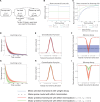Context-dependent memory decay is evidence of effort minimization in motor learning: a computational study
- PMID: 25698963
- PMCID: PMC4316784
- DOI: 10.3389/fncom.2015.00004
Context-dependent memory decay is evidence of effort minimization in motor learning: a computational study
Abstract
Recent theoretical models suggest that motor learning includes at least two processes: error minimization and memory decay. While learning a novel movement, a motor memory of the movement is gradually formed to minimize the movement error between the desired and actual movements in each training trial, but the memory is slightly forgotten in each trial. The learning effects of error minimization trained with a certain movement are partially available in other non-trained movements, and this transfer of the learning effect can be reproduced by certain theoretical frameworks. Although most theoretical frameworks have assumed that a motor memory trained with a certain movement decays at the same speed during performing the trained movement as non-trained movements, a recent study reported that the motor memory decays faster during performing the trained movement than non-trained movements, i.e., the decay rate of motor memory is movement or context dependent. Although motor learning has been successfully modeled based on an optimization framework, e.g., movement error minimization, the type of optimization that can lead to context-dependent memory decay is unclear. Thus, context-dependent memory decay raises the question of what is optimized in motor learning. To reproduce context-dependent memory decay, I extend a motor primitive framework. Specifically, I introduce motor effort optimization into the framework because some previous studies have reported the existence of effort optimization in motor learning processes and no conventional motor primitive model has yet considered the optimization. Here, I analytically and numerically revealed that context-dependent decay is a result of motor effort optimization. My analyses suggest that context-dependent decay is not merely memory decay but is evidence of motor effort optimization in motor learning.
Keywords: context-dependent memory decay; effort minimization; motor learning; motor primitive; neural network modeling.
Figures



Similar articles
-
Learning with slight forgetting optimizes sensorimotor transformation in redundant motor systems.PLoS Comput Biol. 2012;8(6):e1002590. doi: 10.1371/journal.pcbi.1002590. Epub 2012 Jun 28. PLoS Comput Biol. 2012. PMID: 22761568 Free PMC article.
-
A balanced motor primitive framework can simultaneously explain motor learning in unimanual and bimanual movements.Neural Netw. 2017 Feb;86:80-89. doi: 10.1016/j.neunet.2016.10.013. Epub 2016 Nov 3. Neural Netw. 2017. PMID: 27889240
-
Online Visual Feedback during Error-Free Channel Trials Leads to Active Unlearning of Movement Dynamics: Evidence for Adaptation to Trajectory Prediction Errors.Front Hum Neurosci. 2016 Sep 23;10:472. doi: 10.3389/fnhum.2016.00472. eCollection 2016. Front Hum Neurosci. 2016. PMID: 27721748 Free PMC article.
-
The Errors of Our Ways: Understanding Error Representations in Cerebellar-Dependent Motor Learning.Cerebellum. 2016 Apr;15(2):93-103. doi: 10.1007/s12311-015-0685-5. Cerebellum. 2016. PMID: 26112422 Free PMC article. Review.
-
A role for the cerebellum in learning movement coordination.Neurobiol Learn Mem. 1998 Jul-Sep;70(1-2):177-88. doi: 10.1006/nlme.1998.3846. Neurobiol Learn Mem. 1998. PMID: 9753595 Review.
Cited by
-
An Adaptive Motivation Approach to Understanding the 'How' and 'Why' of Wellbeing.Int J Environ Res Public Health. 2022 Oct 6;19(19):12784. doi: 10.3390/ijerph191912784. Int J Environ Res Public Health. 2022. PMID: 36232083 Free PMC article.
-
Detecting the relevance to performance of whole-body movements.Sci Rep. 2017 Nov 15;7(1):15659. doi: 10.1038/s41598-017-15888-3. Sci Rep. 2017. PMID: 29142276 Free PMC article.
-
Development of a Portable Motor Learning Laboratory (PoMLab).PLoS One. 2016 Jun 27;11(6):e0157588. doi: 10.1371/journal.pone.0157588. eCollection 2016. PLoS One. 2016. PMID: 27348223 Free PMC article.
-
Decomposing motion that changes over time into task-relevant and task-irrelevant components in a data-driven manner: application to motor adaptation in whole-body movements.Sci Rep. 2019 May 10;9(1):7246. doi: 10.1038/s41598-019-43558-z. Sci Rep. 2019. PMID: 31076575 Free PMC article.
-
Active lead-in variability affects motor memory formation and slows motor learning.Sci Rep. 2017 Aug 10;7(1):7806. doi: 10.1038/s41598-017-05697-z. Sci Rep. 2017. PMID: 28798355 Free PMC article.
References
LinkOut - more resources
Full Text Sources
Other Literature Sources

